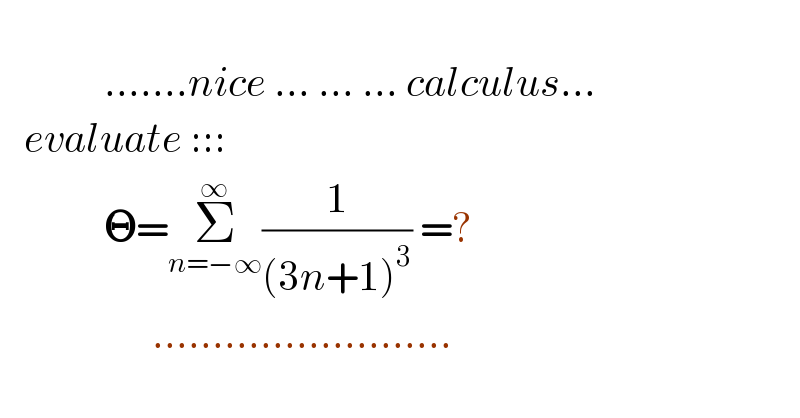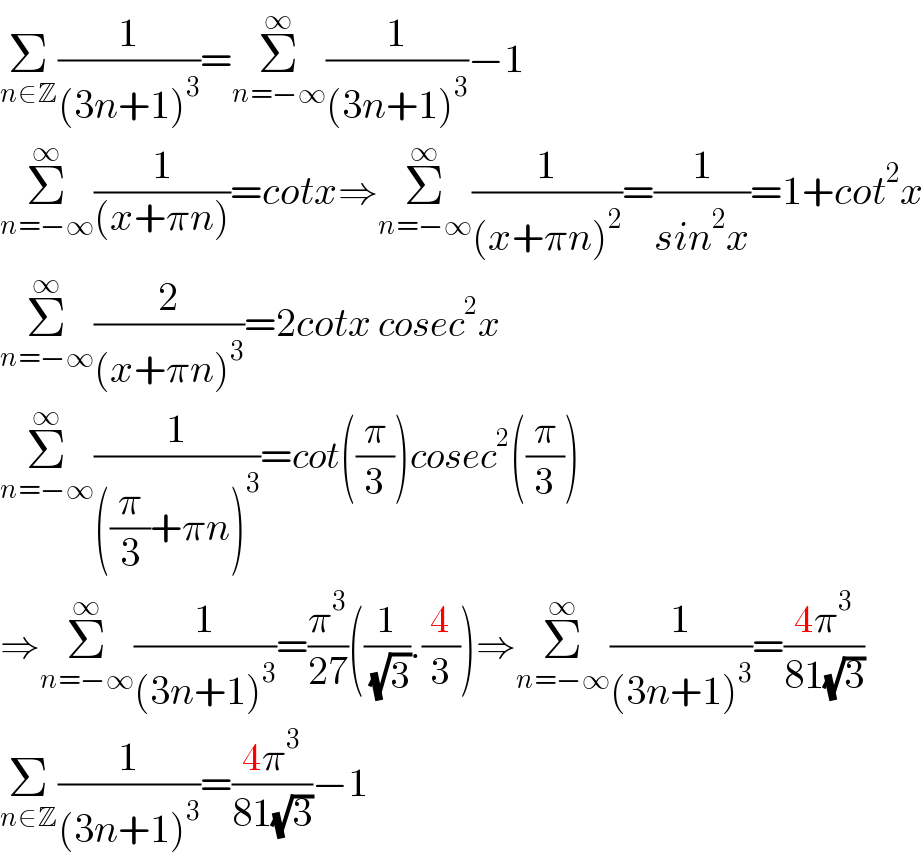
Question Number 138223 by mnjuly1970 last updated on 11/Apr/21

$$\:\:\:\:\:\:\:\:\: \\ $$$$\:\:\:\:\:\:\:\:\:\:\:\:\:.......{nice}\:...\:...\:...\:{calculus}... \\ $$$$\:\:\:{evaluate}\:::: \\ $$$$\:\:\:\:\:\:\:\:\:\:\:\:\:\boldsymbol{\Theta}=\underset{{n}=−\infty} {\overset{\infty} {\sum}}\frac{\mathrm{1}}{\left(\mathrm{3}{n}+\mathrm{1}\right)^{\mathrm{3}} }\:=? \\ $$$$\:\:\:\:\:\:\:\:\:\:\:\:\:\:\:\:\:\:\:......................... \\ $$
Answered by Dwaipayan Shikari last updated on 11/Apr/21

$$\underset{{n}\in\mathbb{Z}} {\sum}\frac{\mathrm{1}}{\left(\mathrm{3}{n}+\mathrm{1}\right)^{\mathrm{3}} }=\underset{{n}=−\infty} {\overset{\infty} {\sum}}\frac{\mathrm{1}}{\left(\mathrm{3}{n}+\mathrm{1}\right)^{\mathrm{3}} }−\mathrm{1} \\ $$$$\underset{{n}=−\infty} {\overset{\infty} {\sum}}\frac{\mathrm{1}}{\left({x}+\pi{n}\right)}={cotx}\Rightarrow\underset{{n}=−\infty} {\overset{\infty} {\sum}}\frac{\mathrm{1}}{\left({x}+\pi{n}\right)^{\mathrm{2}} }=\frac{\mathrm{1}}{{sin}^{\mathrm{2}} {x}}=\mathrm{1}+{cot}^{\mathrm{2}} {x} \\ $$$$\underset{{n}=−\infty} {\overset{\infty} {\sum}}\frac{\mathrm{2}}{\left({x}+\pi{n}\right)^{\mathrm{3}} }=\mathrm{2}{cotx}\:{cosec}^{\mathrm{2}} {x} \\ $$$$\underset{{n}=−\infty} {\overset{\infty} {\sum}}\frac{\mathrm{1}}{\left(\frac{\pi}{\mathrm{3}}+\pi{n}\right)^{\mathrm{3}} }={cot}\left(\frac{\pi}{\mathrm{3}}\right){cosec}^{\mathrm{2}} \left(\frac{\pi}{\mathrm{3}}\right) \\ $$$$\Rightarrow\underset{{n}=−\infty} {\overset{\infty} {\sum}}\frac{\mathrm{1}}{\left(\mathrm{3}{n}+\mathrm{1}\right)^{\mathrm{3}} }=\frac{\pi^{\mathrm{3}} }{\mathrm{27}}\left(\frac{\mathrm{1}}{\:\sqrt{\mathrm{3}}}.\frac{\mathrm{4}}{\mathrm{3}}\right)\Rightarrow\underset{{n}=−\infty} {\overset{\infty} {\sum}}\frac{\mathrm{1}}{\left(\mathrm{3}{n}+\mathrm{1}\right)^{\mathrm{3}} }=\frac{\mathrm{4}\pi^{\mathrm{3}} }{\mathrm{81}\sqrt{\mathrm{3}}}\: \\ $$$$\underset{{n}\in\mathbb{Z}} {\sum}\frac{\mathrm{1}}{\left(\mathrm{3}{n}+\mathrm{1}\right)^{\mathrm{3}} }=\frac{\mathrm{4}\pi^{\mathrm{3}} }{\mathrm{81}\sqrt{\mathrm{3}}}−\mathrm{1} \\ $$
Answered by mnjuly1970 last updated on 11/Apr/21

$$\:{thank}\:{you}\:{so}\:{much}... \\ $$
Commented by Dwaipayan Shikari last updated on 11/Apr/21

$${Sorry}\:{i}\:{had}\:{a}\:{typo}\:.\:{kindly}\:{check} \\ $$
Commented by mnjuly1970 last updated on 11/Apr/21

$$\:{you}\:{are}\:{welcom} \\ $$$$\:{your}\:{answer}\:{is}\:{correct}.{mercey} \\ $$$$\:\:\:\underset{{n}=−\infty} {\overset{\infty} {\sum}}\frac{\mathrm{1}}{\left(\mathrm{3}{n}+\mathrm{1}\right)^{\mathrm{2}} }=\frac{\mathrm{4}\pi^{\mathrm{3}} \sqrt{\mathrm{3}}}{\mathrm{243}}...\checkmark \\ $$
